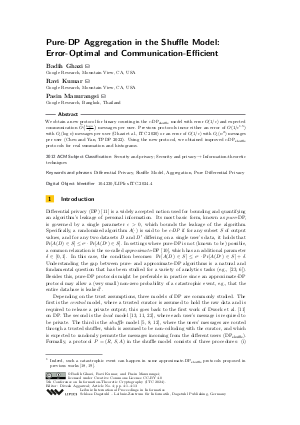Pure-DP Aggregation in the Shuffle Model: Error-Optimal and Communication-Efficient
Authors Badih Ghazi, Ravi Kumar, Pasin Manurangsi
-
Part of:
Volume:
5th Conference on Information-Theoretic Cryptography (ITC 2024)
Part of: Series: Leibniz International Proceedings in Informatics (LIPIcs)
Part of: Conference: Conference on Information-Theoretic Cryptography (ITC) - License:
 Creative Commons Attribution 4.0 International license
Creative Commons Attribution 4.0 International license
- Publication Date: 2024-08-06
File

PDF
LIPIcs.ITC.2024.4.pdf
- Filesize: 0.8 MB
- 13 pages
Document Identifiers
Subject Classification
ACM Subject Classification
- Security and privacy
- Security and privacy → Information-theoretic techniques
Keywords
- Differential Privacy
- Shuffle Model
- Aggregation
- Pure Differential Privacy
Metrics
- Access Statistics
-
Total Accesses (updated on a weekly basis)
0PDF Downloads0Metadata Views
Abstract
We obtain a new protocol for binary counting in the ε-DP_shuffle model with error O(1/ε) and expected communication Õ((log n)/ε) messages per user. Previous protocols incur either an error of O(1/ε^1.5) with O_ε(log n) messages per user (Ghazi et al., ITC 2020) or an error of O(1/ε) with O_ε(n²) messages per user (Cheu and Yan, TPDP 2022). Using the new protocol, we obtained improved ε-DP_shuffle protocols for real summation and histograms.
Cite As Get BibTex
Badih Ghazi, Ravi Kumar, and Pasin Manurangsi. Pure-DP Aggregation in the Shuffle Model: Error-Optimal and Communication-Efficient. In 5th Conference on Information-Theoretic Cryptography (ITC 2024). Leibniz International Proceedings in Informatics (LIPIcs), Volume 304, pp. 4:1-4:13, Schloss Dagstuhl – Leibniz-Zentrum für Informatik (2024)
https://doi.org/10.4230/LIPIcs.ITC.2024.4
BibTex
@InProceedings{ghazi_et_al:LIPIcs.ITC.2024.4,
author = {Ghazi, Badih and Kumar, Ravi and Manurangsi, Pasin},
title = {{Pure-DP Aggregation in the Shuffle Model: Error-Optimal and Communication-Efficient}},
booktitle = {5th Conference on Information-Theoretic Cryptography (ITC 2024)},
pages = {4:1--4:13},
series = {Leibniz International Proceedings in Informatics (LIPIcs)},
ISBN = {978-3-95977-333-1},
ISSN = {1868-8969},
year = {2024},
volume = {304},
editor = {Aggarwal, Divesh},
publisher = {Schloss Dagstuhl -- Leibniz-Zentrum f{\"u}r Informatik},
address = {Dagstuhl, Germany},
URL = {https://drops.dagstuhl.de/entities/document/10.4230/LIPIcs.ITC.2024.4},
URN = {urn:nbn:de:0030-drops-205127},
doi = {10.4230/LIPIcs.ITC.2024.4},
annote = {Keywords: Differential Privacy, Shuffle Model, Aggregation, Pure Differential Privacy}
}
Author Details
References
-
Victor Balcer and Albert Cheu. Separating local & shuffled differential privacy via histograms. In ITC, pages 1:1-1:14, 2020.

-
Borja Balle, James Bell, Adrià Gascón, and Kobbi Nissim. The privacy blanket of the shuffle model. In CRYPTO, pages 638-667, 2019.

-
Borja Balle, James Bell, Adrià Gascón, and Kobbi Nissim. Private summation in the multi-message shuffle model. In CCS, pages 657-676, 2020.

-
Amos Beimel, Kobbi Nissim, and Eran Omri. Distributed private data analysis: Simultaneously solving how and what. In CRYPTO, pages 451-468, 2008.

-
Andrea Bittau, Úlfar Erlingsson, Petros Maniatis, Ilya Mironov, Ananth Raghunathan, David Lie, Mitch Rudominer, Ushasree Kode, Julien Tinnés, and Bernhard Seefeld. Prochlo: Strong privacy for analytics in the crowd. In SOSP, pages 441-459, 2017.

-
Mark Bun, Jelani Nelson, and Uri Stemmer. Heavy hitters and the structure of local privacy. TALG, 15(4):1-40, 2019.

-
T.-H. Hubert Chan, Elaine Shi, and Dawn Song. Optimal lower bound for differentially private multi-party aggregation. In ESA, pages 277-288, 2012.

-
Albert Cheu, Adam D. Smith, Jonathan Ullman, David Zeber, and Maxim Zhilyaev. Distributed differential privacy via shuffling. In EUROCRYPT, pages 375-403, 2019.

-
Albert Cheu and Chao Yan. Pure differential privacy from secure intermediaries. In TPDP, 2022.

-
Cynthia Dwork, Krishnaram Kenthapadi, Frank McSherry, Ilya Mironov, and Moni Naor. Our data, ourselves: Privacy via distributed noise generation. In EUROCRYPT, pages 486-503, 2006.

-
Cynthia Dwork, Frank McSherry, Kobbi Nissim, and Adam Smith. Calibrating noise to sensitivity in private data analysis. In TCC, pages 265-284, 2006.

-
Úlfar Erlingsson, Vitaly Feldman, Ilya Mironov, Ananth Raghunathan, Kunal Talwar, and Abhradeep Thakurta. Amplification by shuffling: From local to central differential privacy via anonymity. In SODA, pages 2468-2479, 2019.

-
Alexandre Evfimievski, Johannes Gehrke, and Ramakrishnan Srikant. Limiting privacy breaches in privacy preserving data mining. In PODS, pages 211-222, 2003.

-
Quan Geng and Pramod Viswanath. The optimal noise-adding mechanism in differential privacy. IEEE Trans. Inf. Theory, 62(2):925-951, 2016.

-
Badih Ghazi, Noah Golowich, Ravi Kumar, Pasin Manurangsi, Rasmus Pagh, and Ameya Velingker. Pure differentially private summation from anonymous messages. In ITC, pages 15:1-15:23, 2020.

-
Badih Ghazi, Noah Golowich, Ravi Kumar, Rasmus Pagh, and Ameya Velingker. On the power of multiple anonymous messages: Frequency estimation and selection in the shuffle model of differential privacy. In EUROCRYPT, pages 463-488, 2021.

-
Badih Ghazi, Ravi Kumar, and Pasin Manurangsi. User-level differentially private learning via correlated sampling. In NeurIPS, pages 20172-20184, 2021.

-
Badih Ghazi, Ravi Kumar, Pasin Manurangsi, and Rasmus Pagh. Private counting from anonymous messages: Near-optimal accuracy with vanishing communication overhead. In ICML, pages 3505-3514, 2020.

-
Badih Ghazi, Ravi Kumar, Pasin Manurangsi, Rasmus Pagh, and Amer Sinha. Differentially private aggregation in the shuffle model: Almost central accuracy in almost a single message. In ICML, pages 3692-3701, 2021.

-
Badih Ghazi, Pasin Manurangsi, Rasmus Pagh, and Ameya Velingker. Private aggregation from fewer anonymous messages. In EUROCRYPT, pages 798-827, 2020.

-
Arpita Ghosh, Tim Roughgarden, and Mukund Sundararajan. Universally utility-maximizing privacy mechanisms. In STOC, pages 351-360, 2009.

-
Shiva Prasad Kasiviswanathan, Homin K. Lee, Kobbi Nissim, Sofya Rashkodnikova, and Adam Smith. What can we learn privately? In FOCS, pages 531-540, 2008.

-
Thomas Steinke and Jonathan Ullman. Between pure and approximate differential privacy. Journal of Privacy and Confidentiality, 7(2):3-22, 2016.

